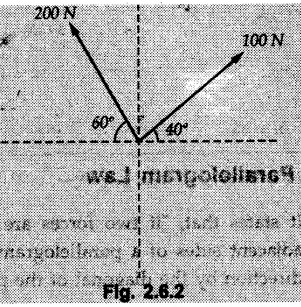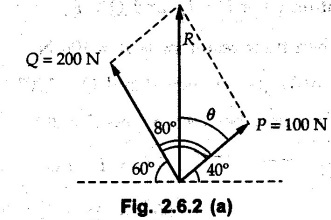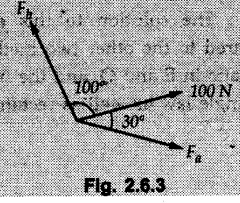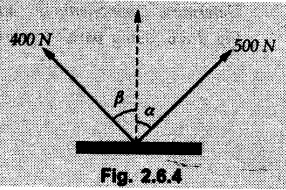Engineering Mechanics: Unit I: Statics of Particles
Solved Example & Practice Problems: Parallelogram law
Examples for Practice: Statics of Particles - Engineering Mechanics
Example 2.6.1 Find resultant of the two forces shown in Fig. 2.6.2 using parallelogram law. Solution: Let P= 100 N and Q = 200 N then a = 80°. Complete the parallelogram by drawing lines parallel to the given forces. The diagonal drawn from the common point represents their resultant which makes angle θ with P. Refer Fig. 2.6.2 (a). Example 2.6.2 Find components F and Ep of the 100 N force along the directions shown in Fig. 2.6.3 using parallelogram law. Solution: Let P = Fa and Q = Fb Then their resultant is R = 100 N. α = Angle between P and Q = 130° θ = Angle between R and P = 30° Using equation (2), Fa can be expressed in terms of Fb which can then be substituted in equation (1). Fa tan 30 + Fb cos 130 tan 30 = F sin 130 Note: The solution to this example is more lengthy using parallelogram compared to the other two methods as one of the equations in parallelogram law is quadratic in P and Q and the other is linear. In triangle law as well as rectangular components, both the equations are linear. Example 2.6.3 If the resultant of the two forces shown in Fig. 2.6.4 is 700 N directed vertically upwards, find the angles a and ß using parallelogram law. Solution: Let P = 500 N, Q = 400 N, R = 700 N. Then angle between P and Q = α' = α + β and angle between R and P is θ = α Note: The parallelogram law and the triangle law give solution in less number of steps compared to resolution in rectangular components when two angles are unknown. The above two problems can also be solved using Lami's theorem as illustrated in the next section. Examples for Practice Q.1 Find resultant of the two forces shown in Fig. 2.6.5 using parallelogram law. [Ans.: R = 377.68 N, θ = 44.41° Q.2 Determine components Fa and Fb of the 500 N force along the directions shown in Fig. 2.6.6. using parallelogram law. [ Ans.: Fa = 442.28 N Fb = 542.53 N] Q.3 If the resultant of the two forces shown in Fig. 2.6.7 is 90 kN directed vertically upwards, find the angles α and β using parallelogram law. [Ans.: α = 39.29°, β = 56.44°]Solved Examples for Understanding








![]() ]
]


Engineering Mechanics: Unit I: Statics of Particles : Tag: : - Solved Example & Practice Problems: Parallelogram law
Related Topics
Related Subjects
Engineering Mechanics
ME3351 3rd semester civil, Mechanical Dept | 2021 Regulation | 3rd Semester Mechanical Dept 2021 Regulation
